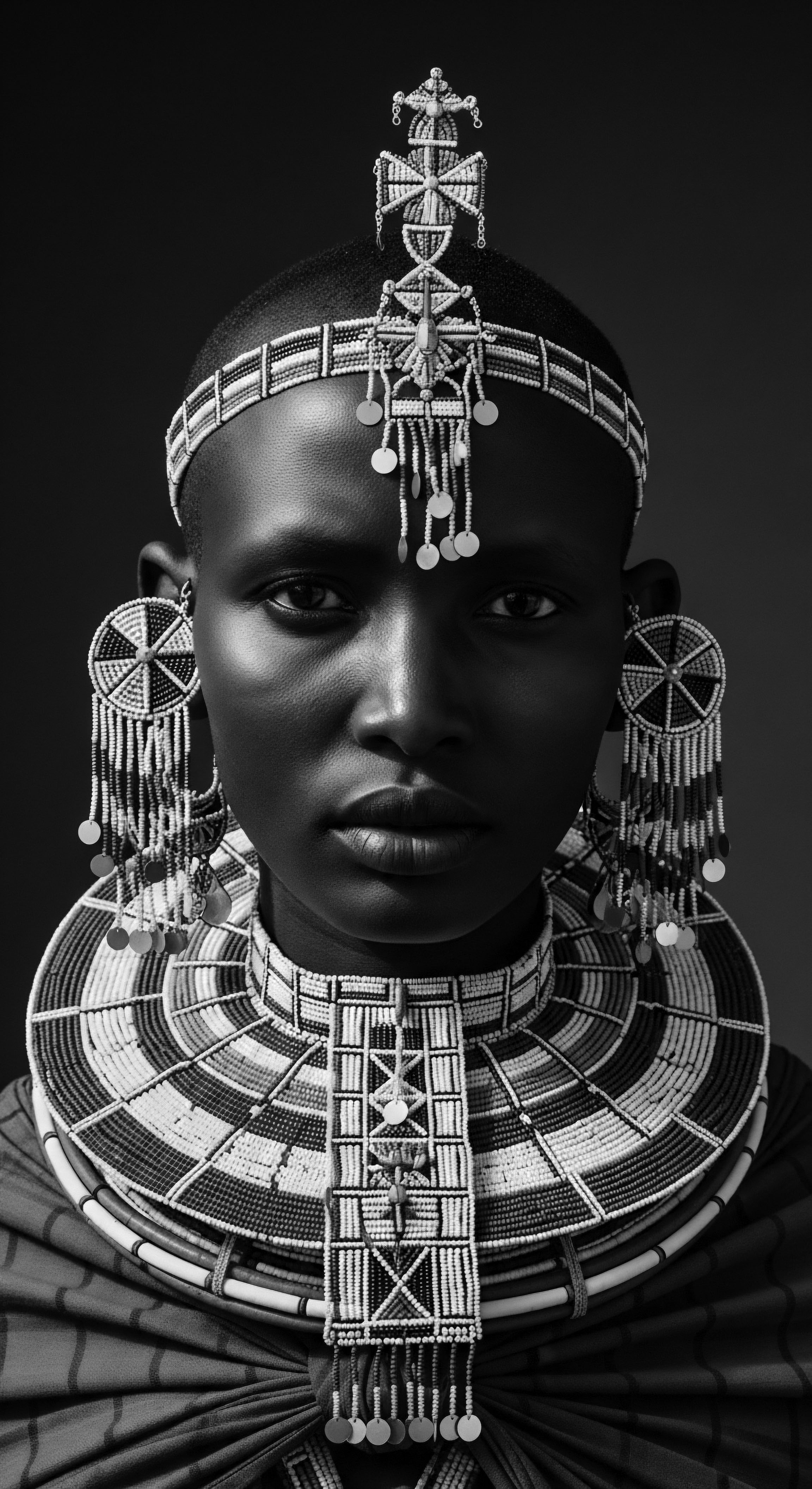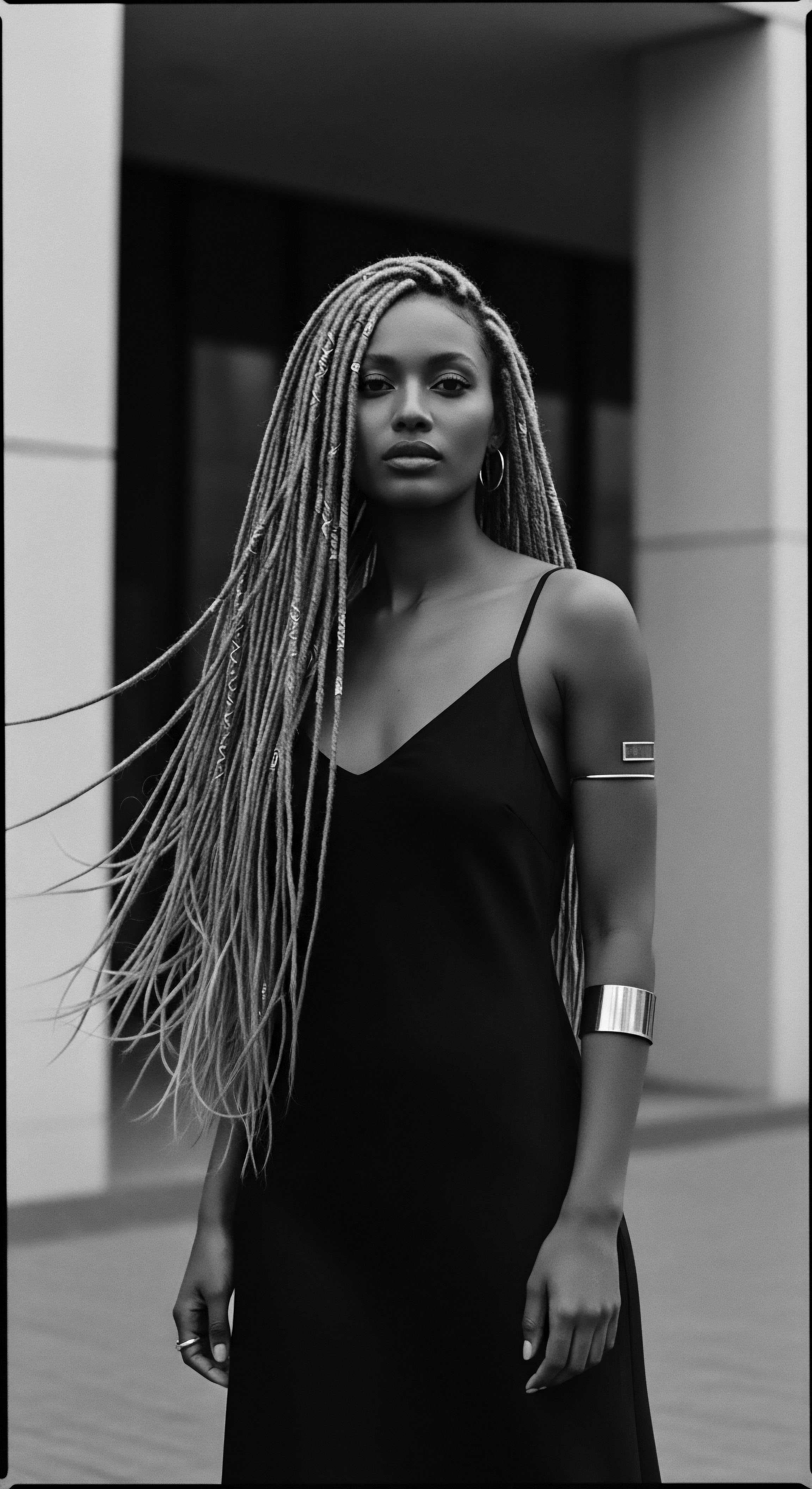
Roots
In the expansive tapestry of Chadian heritage, where sun-drenched plains meet ancient mountains, hair emerges as a profound repository of ancestral wisdom and identity. It is not merely a biological outgrowth; it represents a living chronicle, a connection to the very origins of a people’s journey. For generations, the length of one’s hair, its texture, and the rituals surrounding its care, have spoken volumes, silently communicating status, spirituality, and belonging across diverse communities.
This profound regard for hair finds its roots in the fundamental understanding of textured hair itself, a wisdom passed down through oral traditions and lived practices, long before modern scientific inquiry. It speaks to a deep, inherent recognition of hair’s elemental presence as an extension of self and spirit.

Textured Hair’s Ancestral Blueprint
The intricate coils, curls, and kinks that characterize textured hair in Chadian communities possess a unique structural integrity, a resilience forged in the Sahelian environment. Ancestral beliefs, though unarticulated in contemporary scientific terms, intuitively grasped the protective qualities of these hair structures. The dense packing of coiled strands, for instance, naturally shields the scalp from intense sun and harsh winds, a subtle yet significant adaptation. The way each strand spirals, creating volume and a natural barrier, was understood through generations of observation, influencing traditional styling practices that honored its inherent nature.
Ancestral reverence for hair length in Chad is deeply intertwined with cultural identity, spiritual beliefs, and community narratives.
While modern cosmetology categorizes textured hair into types and subtypes, Chadian heritage held its own system of classification, often tied to social roles, rites of passage, or familial lineage. Hair that reached certain lengths might signify maturity, marital eligibility, or a particular spiritual alignment. This ancestral understanding transcended mere aesthetics; it grounded hair within a holistic framework of well-being, where physical attributes reflected inner states and communal standing.

Lexicons of Length and Lore
The language surrounding hair in Chadian heritage reveals a rich lexicon, distinct from the Western scientific classifications. Terms for various lengths or styles often carry symbolic weight, reflecting cultural narratives and historical practices. Consider the Basara Arab women of Chad, celebrated for their exceptionally long, thick hair, often extending past the waist or even to the thighs.
This length is not simply a genetic predisposition; it is a meticulously preserved heritage, nurtured through centuries-old rituals. The very existence of this length is a testament to the ancestral care practices and the profound belief in hair as a physical manifestation of vitality and femininity.
- Chebe ❉ A powdered blend of herbs, seeds, and plants, central to length retention for Basara women, passed down through generations.
- Gourone ❉ A traditional hairstyle consisting of several large thick plaits and thinner braids, often associated with the application of Chebe.
- Goron ❉ Intricate small braids along the hairline and middle parts, sometimes adorned with jewelry, designed for edge control and neat patterns.

Cycles of Growth and Environmental Echoes
Hair growth cycles, though a biological constant, were interpreted through an ancestral lens, connecting the body’s rhythms to the natural world. Seasonal shifts, the availability of specific botanicals, and communal ceremonies often dictated the timing of significant hair care practices. The use of traditional ingredients, often sourced from the immediate environment, reflects a deep ecological knowledge. The Croton zambesicus plant, locally known as Chebe, for instance, grows wild in the Guéra Massif mountains of Northern Chad.
Its seeds, harvested, dried, roasted, and ground into powder, are the cornerstone of the Basara women’s hair care ritual. This ancestral knowledge, predating written records by thousands of years – with prehistoric cave paintings even depicting men applying Chebe, according to Salwa Petersen, a Chadian-French founder of a beauty line (Petersen, 2022) – underlines a symbiotic relationship between humanity and nature, where hair length was not just allowed but actively encouraged and sustained through sustainable practices. This continuous, generational application of Chebe powder is documented to strengthen the hair shaft, reduce split ends, and thereby improve elasticity, allowing natural hair to retain its length without breaking, rather than stimulating new growth from the scalp.

Ritual
In Chad, hair is a sacred canvas upon which ancestral wisdom is rendered, a living tradition where styling is both an art and a science, imbued with profound cultural meaning. The meticulous techniques, the purpose-built tools, and the transformative power of these practices are not merely about aesthetics; they are deeply rooted in heritage, reflecting a continuous dialogue between past and present. The length of one’s hair, therefore, becomes a central tenet in these rituals, often dictating the type of adornment, the intricacy of the style, or the social messages conveyed.

Protective Styling Ancestry
The practice of protective styling, so celebrated in contemporary textured hair care, finds its profound origins in Chadian ancestral traditions. Styles such as braids and twists were not simply fashion statements; they were ingenious methods to shield hair from the harsh desert climate, preventing breakage and promoting length retention. The Basara Arab women , for example, apply their Chebe mixture to damp, sectioned hair, which is then braided and left for days, sometimes weeks.
This ancient technique protects the hair from environmental damage, allowing it to grow to remarkable lengths. These styles, often intricate and time-consuming, doubled as social gatherings, transforming hair care into a communal bonding activity, where stories and traditions were exchanged among mothers, sisters, and daughters.

Does Hair Length Define Identity in Chadian Communities?
Hair length frequently carries significant symbolic weight within Chadian societies, extending beyond mere physical appearance. For many ethnic groups, specific lengths or styles could signal one’s social status, marital standing, age, or even religious affiliation. The Fulani people , a widespread nomadic community across West and Central Africa including Chad, have a rich tradition of braids where patterns and length can vary, often incorporating special filaments or spiral designs. While modern interpretations of Fulani braids have evolved globally, the core practice remains an important part of their cultural identity and heritage, emphasizing how hair communicates identity and history.
Traditional Chadian hair rituals symbolize femininity, vitality, and the enduring connection to ancestral practices.
In some contexts, long hair might signify a woman’s journey through various life stages, from maidenhood to motherhood, each transition marked by specific changes in length, style, or adornments. The act of growing and maintaining long hair is itself a rite, a dedication to a heritage that values natural growth and protective care.

Tools of Transformation and Tradition
The complete Chadian textured hair toolkit extends far beyond modern combs and brushes. It comprises elements drawn from the natural world, reflecting an intimate understanding of the environment and its offerings. Hand-carved wooden combs, often adorned with symbolic motifs, served to gently detangle and section the hair. Cowrie shells, beads, and sometimes silver or gold coins would be woven into braids, signifying wealth, social status, or marital status.
These adornments, particularly when accompanying long, carefully tended hair, spoke a visual language unique to each community. The traditional application of Chebe powder with oils or butters requires specific methods of sectioning and braiding that have been refined over centuries.
The Kanuri people , a dominant cultural group in the Lake Chad region with a history stretching back over a thousand years to the Kanem and Bornu Empires, also exhibit a deep reverence for their culture and hair practices. Kanuri women are known for their distinct hairstyles and tattoos. While explicit details on hair length beliefs for every single Chadian group are not widely documented, the emphasis across various groups points to hair as a central marker of cultural continuity.
| Ancestral Practice Chebe Powder Application |
| Heritage Significance Used by Basara women for millennia to retain length by preventing breakage and locking in moisture. |
| Ancestral Practice Protective Braiding |
| Heritage Significance Shields hair from environmental damage, preserves length, and serves as a communal bonding activity. |
| Ancestral Practice Adornment with Natural Elements |
| Heritage Significance Beads, cowrie shells, and coins woven into hair to signify status, wealth, or marital state. |
| Ancestral Practice Holistic Ingredient Sourcing |
| Heritage Significance Ingredients like Chebe and various oils from the Sahel region reflect deep ecological knowledge and self-reliance. |
| Ancestral Practice The enduring presence of these ancestral practices highlights a profound connection to Chadian heritage, shaping contemporary hair care. |

Relay
The ancestral beliefs surrounding hair length in Chadian heritage, far from being relics of the past, constitute a vibrant, living legacy that continues to shape identity, community, and well-being. This profound understanding of hair, particularly its textured forms, represents a sophisticated interplay of environmental adaptation, cultural symbolism, and ancestral wisdom, a legacy passed down through generations. We see this not as static tradition, but as a dynamic, evolving relay of knowledge.

How Does Ancestral Wisdom Inform Modern Hair Health?
The regimen of radiance for textured hair in Chad is deeply rooted in ancestral philosophies, often drawing from practices that prioritize natural ingredients and holistic care. While contemporary hair care might fragment into individual products for specific concerns, the ancestral approach considered hair health as an extension of overall physical and spiritual well-being. The emphasis on length retention, a defining characteristic of Basara women’s hair care, is a powerful historical example.
Rather than focusing on rapid growth, the Chadian Chebe ritual cultivates an environment where hair can reach its genetic potential by minimizing breakage. This approach involves coating the hair to provide lubrication and protection, thereby preventing the fragility that often characterizes textured hair.
This prevention of breakage leads to observable length, demonstrating that the wisdom of preserving hair, rather than forcing growth, has stood the test of time. This ancestral emphasis on nurturing the existing hair shaft, rather than solely stimulating the follicle, presents a paradigm for modern care that prioritizes resilience and integrity.

Nighttime Sanctuaries and Sacred Strands
Nighttime rituals, though perhaps less overtly ceremonial than daytime styling, hold significant purpose in preserving hair length and health within Chadian heritage. While the modern bonnet serves a similar function, ancestral practices involved careful wrapping and protection of hair during sleep, often with fabrics chosen for their breathability and smoothness. This deliberate protection of hair from friction and tangling during rest was crucial for retaining length, reinforcing the understanding that constant, gentle care was the bedrock of long, healthy hair. This dedication extended to the entire hair shaft, as the traditional Chebe application is typically kept in the hair for days, sometimes weeks, without washing, acting as a continuous protective coating.
This enduring practice safeguards the hair against the rigors of daily life and sleep, reducing manipulation and preserving the integrity of the strand, thus allowing the natural length to flourish without constant loss. It highlights a deep respect for hair as something precious, something that requires sustained reverence.

Chadian Ingredients and Ancestral Apothecaries
The ingredient deep dives into Chadian hair care traditions reveal a pharmacopoeia of natural elements, each chosen for specific properties believed to contribute to length and vitality. The Chebe powder itself is a complex blend, typically including Croton zambesicus, Mahllaba Soubiane (cherry kernels), cloves, resin, and stone scent. These components work synergistically ❉ the Croton zambesicus provides strengthening properties, while the other ingredients contribute to moisture retention and a pleasant scent. Historically, these powders were often mixed with animal fat or shea butter, forming a nourishing paste that was liberally applied to the hair.
This traditional approach emphasizes a direct connection to the land and its bounty, a recognition that true hair health stems from natural, potent sources. It underscores the profound ecological wisdom of ancestral communities, who knew how to harness the earth’s gifts for their well-being.
The problem-solving compendium within Chadian hair heritage also points to a holistic understanding of hair challenges. Breakage, a common concern for textured hair, was addressed not through harsh chemicals but through consistent protective styling and regular application of fortifying mixtures like Chebe. This ancestral practice demonstrates a deep, intuitive knowledge of hair physics , where coating the strands reduces friction and minimizes the mechanical stresses that lead to breakage. The traditional absence of applying Chebe directly to the scalp, focusing it instead on the hair strands, further illustrates an awareness of potential scalp irritation and a nuanced understanding of product application for length retention.
- Reduced Breakage ❉ The protective coating from Chebe and braiding reduces friction and environmental exposure, allowing hair to retain its length.
- Moisture Retention ❉ Ingredients within Chebe and the method of application create a sealed environment, keeping hair hydrated.
- Hair Elasticity ❉ Consistent care with traditional mixtures improves the hair’s ability to stretch without breaking, a key factor in length.
The enduring health and length of hair seen in many Chadian women, particularly those who maintain ancestral practices, serve as a living validation of this heritage. It is a testament to the fact that scientific principles, often viewed as modern discoveries, frequently echo the long-standing observations and wisdom of ancient cultures. Hair in this context is not just a personal attribute; it is a profound cultural marker, an unbroken chain connecting the past to the present, embodying the resilience and deep ancestral wisdom of the Chadian people. The spiritual significance of hair in some African traditions, where it is considered a sacred symbol and a conduit for divine energy, further elevates its status beyond mere aesthetics.

Reflection
As we contemplate the ancestral beliefs surrounding hair length in Chadian heritage, a profound narrative unfolds, one that stretches far beyond the mere physical attribute of strands. It is a testament to the enduring human spirit, a testament to the wisdom that flows through generations, speaking of connection, reverence, and identity. Each coil, each extended length, becomes a whispered story of resilience, of cultural affirmation in a world too often quick to dismiss or misunderstand the textured crown. This journey through Chadian ancestral practices, from the elemental biology of hair to its role in shaping futures, reminds us that hair is indeed a living, breathing archive, a testament to the Soul of a Strand.
The deep respect for natural length, the intricate rituals, and the communal bonding that underpins these traditions paint a vivid picture of a heritage that sees hair as sacred. It is a continuous conversation between ancient earth wisdom and the contemporary self, an invitation to honor the inherent beauty and strength of textured hair as a profound link to ancestral narratives. The legacy of Chadian hair, therefore, is not merely about inches retained; it is about the stories preserved, the spirits acknowledged, and the vibrant identity continually expressed through every cherished strand. It teaches us that true beauty blossoms from a place of deep respect, of understanding one’s roots, and of carrying forward the luminosity of shared history into the unfolding future.

References
- Petersen, S. (2022). Chébé Powder’s Ancient Roots Could Be The Key To Long, Strong Hair. The Zoe Report.
- Obscure Histories. (2024). Ancient Gems ❉ A Historical Survey of African Beauty Techniques. Obscure Histories.
- Madison Manor. (2025). Chad Women ❉ Untold Stories, Shocking Stats & Inspiring Resilience!. Madison Manor.
- Curl Witch. (2024). The Power of Ritualistic Hair Cutting ❉ Connecting Spirit to Hair. Curl Witch.
- YouTube. (2022). Chad Magical Chebe Powder Giving Africans Long Natural Hair. YouTube.
- Marie Claire Nigeria. (2025). 5 timeless beauty rituals from across Africa. Marie Claire Nigeria.
- Quora. (2018). Why do Africans have short hair compared to whites?. Quora.
- Kumakonda. (2023). The Wodaabe of Chad ❉ origins, symbols and relationships in Gerewol. Kumakonda.
- Madhu Chanda das. (2024). The Significance of Hair ❉ Cultural Wisdom and Spiritual Symbolism. Madhu Chanda das.
- OkayAfrica. (2026). A Regional Walk Through The History of African Hair Braiding. OkayAfrica.
